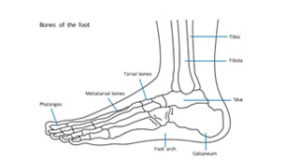“All of the staff were great. Thank you Mr Murphy for the great job you did on my big toe. Please say a big thank you to everyone”
What to expect
CONSULTATION
We understand that you may have questions and concerns about treatment of your foot condition, but there is no need to worry. Most conditions can be treated without surgery and where surgery is required Mr Murphy and our team will be with all the way from
pre- operative planning, providing you with all the information you need to make an informed decision on your care, right through surgical proedure and post-operative care. Remember we are here to help improve your quality of life and reduce any pain that you may be suffering. Why not talk to us today?
WHAT IF I NEED SURGERY?
The foot is a complicated part of the body and consists of 26 bones, 33 joints and numerous tendons, ligaments and muscles. Sometimes the structure and mechanics of your feet or ankles change and surgery may be required to address problems. Most procedures we carry out are common and you are in good hands in our clinics.
PRIOR TO ADMISSION
ADMISSION
WHAT TO EXPECT FOLLOWING SURGERY
POST OPERATIVE ADVICE
PRIOR TO ADMISSION
You should think about some of the practicalities of post surgery as there will be a healing process required where you will not have full mobility in your foot or feet. Do you have?
- someone able to help you carry out basic every day tasks such as shopping or even cooking?
- Will getting up and down stairs be a problem? Do you have hand rails?
- If your toilet is downstairs, would it be easier to have your bed downstairs until you have sufficiently recovered to be able to manoeuvre up and down the stairs safely?
We will discuss practicalities with you and where required put you in touch with an occupational therapist or other relevant health workers to help you with these arrangements,
WHAT TO EXPECT FOLLOWING SURGERY
Following surgery, you may be wearing a sterilised bandage or plaster of paris cast. Your operated leg will be elevated either on pillows or on a special frame. It is important to keep your leg elevated in order to reduce swelling, bleeding or any discomfort. The bandage/cast and stitches or clips are usually removed around 14 days later.
Dependent on the procedure you may have joint stiffness and a walking assessment will be carried out and where required walking aids provided and exercises to aid healing.
ADMISSION
On admission for surgery here are a few other things to consider.
- Make sure you have a flat sturdy shoe to wear on the un-operated foot following surgery.
- You should ensure all cosmetics are removed from your feet. Where possible clean under your toes and cut nails.
- You should also tell us of any medication you are taking, this includes herbal remedies, blood pressure medication or the contraceptive pill.
Most foot surgery is performed under general anaesthetic. However, a local anaesthetic can be used with a sedative and we will discuss this with you before surgery. A local anaesthetic will numb the area and help with pain relief immediately following the procedure. The feeling of numbness may last between 12 to 24 hours following your operation, but this is completely normal
POST OPERATIVE ADVICE
The key to your healing will be to rest and keep your foot elevated. Following surgery your foot and ankle area may swell and this can lead to problems with the wound healing. It is important you have some time off after surgery to allow for healing.
Once the dressings are removed, sometimes the application of an ice-pack will aid the swelling. You will be informed of when it is safe to return to driving. We would not recommend attempting to drive following surgery.
For full information on what to expect from surgery please download our guide here

